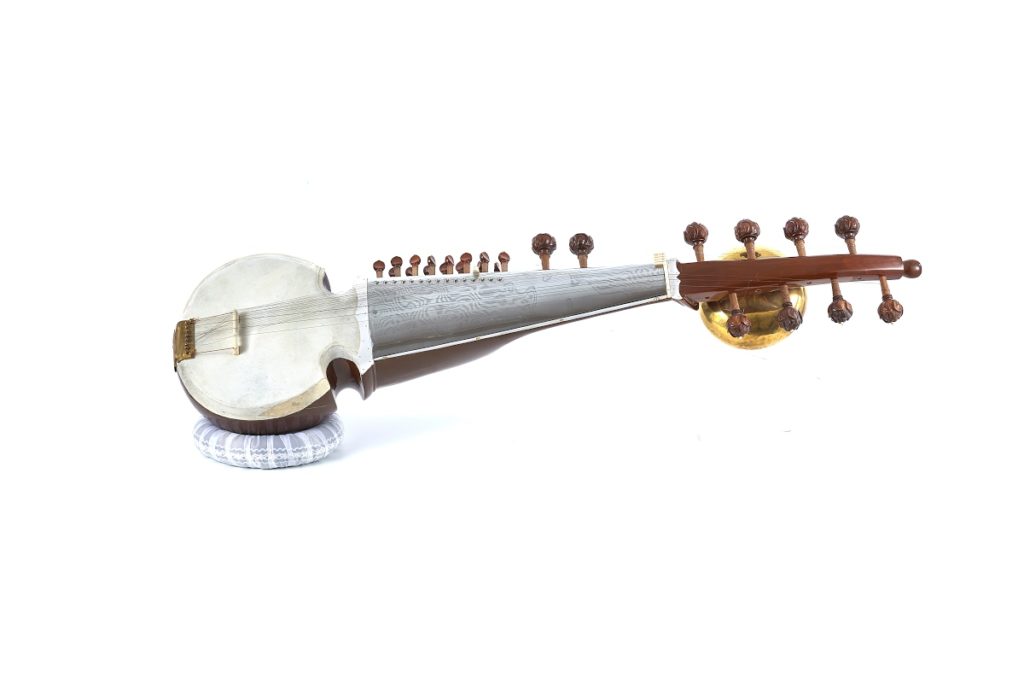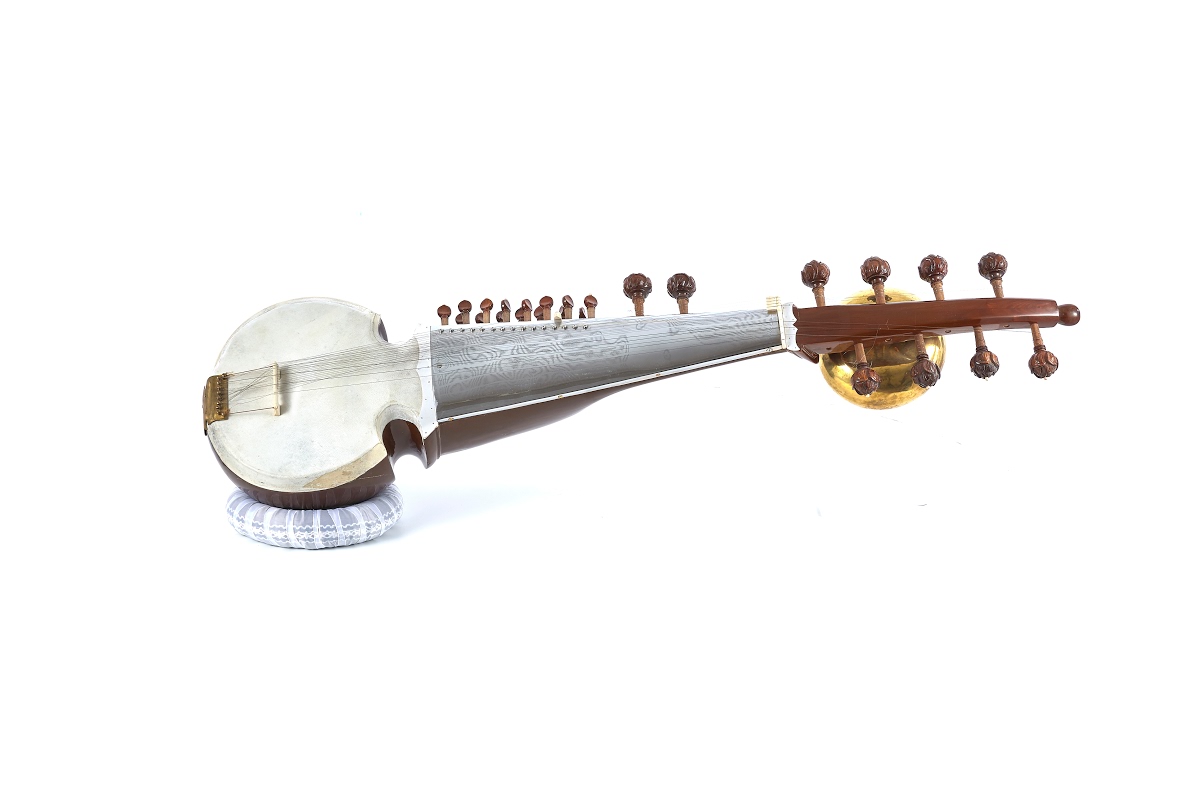The sarod is a mesmerizing and complex musical instrument that holds a significant place in the classical music traditions of India. Originating from the Indian subcontinent, particularly in Afghanistan and Northern India, the sarod has evolved over centuries to become a key instrument in both Hindustani classical music and folk traditions.

What is a Sarod?
The sarod belongs to the lute family of instruments and is characterized by its distinctive shape and construction. It typically features a polished metal fingerboard with no frets, allowing for a smooth gliding of the player’s fingers. The body of the sarod is carved from a single block of wood, often teak or mahogany, and the top is covered with a stretched membrane made of goat skin. The resonator, called the kaddu, enhances the instrument’s tonal qualities.
The traditional sarod is a lute-like instrument with 17 to 25 strings. It comprises four to five main strings dedicated to playing the melody, one or two drone strings, two chikari strings, and nine to eleven sympathetic strings.
One of the unique features of the sarod is its sympathetic strings, which are beneath the main playing strings. These sympathetic strings resonate in sympathy with the played notes, creating a rich and resonant sound. The sarod usually has around 25 to 26 strings in total, with the player plucking the main melody strings using a plectrum, or javari, held between the index finger and thumb.
The intricate design and craftsmanship of the sarod contribute to its versatility in expressing a wide range of musical emotions. Its repertoire includes both slow, meditative compositions and fast-paced, rhythmic pieces. Sarod players, known as sarodiyas, undergo extensive training to master the nuances of their instrument, including intricate ornamentation, rhythmic patterns, and improvisation.
Prominent sarod players, such as Ustad Amjad Ali Khan and Ali Akbar Khan, have contributed significantly to the popularity and evolution of this enchanting instrument. The sarod’s ability to convey the deep emotional and spiritual dimensions of Indian classical music makes it a revered and cherished instrument in the rich tapestry of Indian musical heritage.
What is the difference between a Banjo and a Sarod?
The banjo and the sarod are distinct musical instruments with unique characteristics, origins, and roles in different musical traditions.
- Origins and Cultural Context:
- Banjo: The banjo is believed to have African origins and was introduced to the Americas by enslaved Africans. It became a prominent instrument in American folk and bluegrass music, particularly associated with genres like country and Appalachian folk.
- Sarod: The sarod has its roots in Afghanistan and Northern India. It is a classical instrument in Hindustani classical music, deeply ingrained in the cultural and musical traditions of South Asia.
- Construction and Design:
- Banjo: The banjo typically has a circular body with a stretched membrane (head) covering it. It features a resonator on the back and has a fretted neck with steel or nylon strings. The sound is often bright and percussive.
- Sarod: The sarod has a carved, teak or mahogany wooden body, covered with a stretched membrane made of goat skin. It has a metal fingerboard with no frets, allowing for smooth gliding of the fingers. It has sympathetic strings underneath the main strings, contributing to its resonant sound.
- Playing Technique:
- Banjo: The banjo is typically played by plucking or strumming the strings, and it is often associated with a distinctive rolling fingerpicking technique.
- Sarod: The sarod is played by plucking the main melody strings with a plectrum held between the index finger and thumb. It involves intricate ornamentation, complex rhythmic patterns, and improvisation.
- Musical Style:
- Banjo: The banjo is prominent in various American musical styles, including bluegrass, country, folk, and old-time music.
- Sarod: The sarod is a classical instrument used in the performance of intricate and emotive compositions in Hindustani classical music.
- Cultural Significance:
- Banjo: The banjo has played a significant role in the cultural history of the Americas, particularly in the context of African American contributions to music.
- Sarod: The sarod is deeply rooted in the classical music traditions of South Asia, representing centuries of cultural heritage and artistic expression.
In summary, while both instruments are stringed and involve plucking, the banjo and the sarod differ significantly in their origins, cultural contexts, construction, playing techniques, and musical styles.
Is a Sarod difficult to play?
So, is the sarod difficult to play? The answer is a resounding yes, especially for beginners. Here’s why:
- Fretless Design: Unlike most string instruments, the sarod lacks frets, those raised metal strips that mark specific notes. This absence necessitates a highly developed sense of pitch and finger placement for accurate note production. It takes dedicated practice to train your ear and muscle memory to achieve precise intonation.
- String Tension: The sarod’s strings are quite tense, requiring significant finger strength to press them down onto the fingerboard and produce clear notes. Beginners might find their fingers fatigue easily, making playing an endurance test.
- Playing Techniques: Mastering the sarod involves a unique blend of techniques. Plucking the strings with the right hand’s fingernails while simultaneously manipulating the strings with the left hand to achieve embellishments and slides requires a high level of coordination.
- Slide Emphasis: Unlike fretted instruments where notes are produced cleanly, the sarod excels in expressive slides (glissandos) between notes. Mastering these smooth transitions demands precise finger control and practice.
However, the challenge doesn’t diminish the instrument’s allure. With dedication and proper guidance, the sarod’s complexities can be overcome. Here’s what can ease the learning curve:
- Start Young: A strong foundation in music theory and ear training helps tremendously. Ideally, beginning to learn the sarod at a young age, when dexterity and aural skills develop more readily, can be advantageous.
- Find a Good Teacher: A seasoned sarod player can provide invaluable guidance on technique, posture, and overcoming the specific challenges of the instrument. Their expertise can make a world of difference in your progress.
- Patience and Perseverance: The sarod rewards dedication. Accept that mastery takes time, and celebrate every milestone as you develop your skills and produce those beautiful, expressive sounds.
While the sarod presents a significant challenge, its rich tonal tapestry and the satisfaction of conquering its complexities make it a truly rewarding instrument to learn.
Who is the famous player of sarod?
The world of sarod boasts several legendary players, each leaving their mark on the instrument’s tradition. Here are a few of the most renowned:
- Ustad Amjad Ali Khan: A true maestro, Amjad Ali Khan is considered one of the greatest sarod players of all time. He is known for his virtuosity, clear and fast taans (rapid melodic passages), and his dedication to preserving and innovating the sarod tradition.
- Ustad Ali Akbar Khan: Another towering figure, Ali Akbar Khan was a sarod maestro and composer who popularized the instrument globally. His masterful playing and focus on melody continue to inspire generations of sarod players.
- Pandit Shiv Kumar Sharma: Renowned for his soulful and expressive playing style, Pandit Shiv Kumar Sharma is credited with creating the “slow santoor style” of sarod playing, characterized by a more contemplative and melodic approach.
- Ayaan Ali Khan and Amaan Ali Khan: The sons of Amjad Ali Khan, Ayaan and Amaan are virtuoso sarod players who perform together. They are known for their innovative approach, incorporating elements of other genres while staying true to the instrument’s heritage.
- Other Notable Players: This list isn’t exhaustive. Other prominent sarod players include maestros like Buddhadev Dasgupta, Sharan Rani Backliwal, and Rajeshwari S. Kanth.
These are just a few examples, and the world of sarod is rich with talented artists. Exploring the work of these legendary players and contemporary masters can provide a wealth of inspiration for anyone interested in the sarod’s captivating sound.
What strings are on a Sarod?
The strings on a sarod are typically made of either steel or phosphor bronze.
Here’s a breakdown of the strings on a sarod:
- Number of Strings: A traditional sarod has 25 strings, although some variations might have 17 to 23 strings. These strings can be categorized into three main groups:
- Main Strings (4-5 strings): These are the strings primarily used for playing the melody.
- Drone Strings (1-2 strings): These strings produce a continuous drone tone that serves as a harmonic foundation.
- Sympathetic Strings (9-11 strings): These strings vibrate in sympathy with the other strings, adding richness and complexity to the overall sound.
- Material: As mentioned earlier, the strings are traditionally made of steel or phosphor bronze.
- Steel strings: These offer a bright and clear sound, but can be harder on the fingers due to their higher tension.
- Phosphor bronze strings: These provide a warmer and mellower tone compared to steel strings, and are generally easier on the fingers.
- Modern vs. Traditional: In the past, sarod strings were made by hand using metal wires. However, today, most players use commercially available steel or phosphor bronze strings specifically designed for the sarod. These pre-made strings offer consistency and ease of replacement.
- String Selection: The choice between steel and phosphor bronze strings depends on the player’s preference for tone and playing style. Some factors to consider include:
- Desired Brightness: Steel strings offer a brighter sound, while phosphor bronze provides a warmer tone.
- Finger Strength: Beginners might find steel strings more challenging due to their higher tension. Phosphor bronze can be a good starting point.
- Musical Genre: The specific genre of music being played might influence string selection.
Here are some additional points to note:
- String Gauges: Sarod strings come in different gauges (thicknesses). Players can experiment with different gauges to find the ones that feel most comfortable and produce the desired sound.
- String Care: Regularly cleaning and replacing strings is important to maintain optimal sound quality and playing experience.
Free Banjo Tabs
Free Online Banjo Lessons
Learn the Banjo in 24 hours
10 Punk Songs Featuring Banjo
10 Metal Songs Featuring Banjo
10 Musicals that Feature the Banjo
10 TV Shows that Feature the Banjo
Can a Monkey Play The Banjo?
What is an Akonting?

